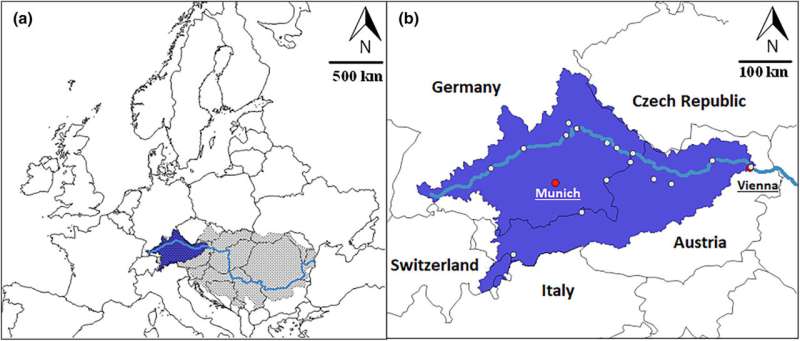This article has been reviewed according to Science X's editorial process and policies. Editors have highlighted the following attributes while ensuring the content's credibility:
fact-checked
peer-reviewed publication
trusted source
proofread
Fish in the upper Danube could be just as endangered in the future as in the past, but for different reasons

Rivers belong to the most threatened ecosystems on Earth. While many studies have projected climate change effects on species, little is known about the severity of these changes compared to historical alterations.
Researchers led by the Leibniz Institute of Freshwater Ecology and Inland Fisheries (IGB) and the German Center for Integrative Biodiversity Research (iDiv) explored the vulnerability of 48 native fish species in the upper Danube River Basin to past and potential future environmental changes.
They show that fish have been particularly sensitive to changes in flow regimes in the past, while higher temperatures will pose the greatest threat in the future. The threat assessment will remain at least as high in the future. However, it could probably be mitigated by reconnecting former floodplains and improving river connectivity. The study is published in Diversity and Distributions.
Almost a third of all freshwater species are threatened with extinction—and a quarter of all known freshwater fish species—and so freshwaters are some of the most vulnerable ecosystems on earth. Fish species in river ecosystems are sensitive to alterations in discharge and temperature. Human interventions such as straightening and damming have historically altered river flows around the world, negatively affecting fish abundance, demography and diversity.
When assessing the conservation needs of freshwater biodiversity under future climate change scenarios, it is important to understand the often dramatic historical environmental changes and their effects on species or populations.
"Fish communities in the upper Danube River Basin have already come under severe pressure over the last 200 years due to massive changes in the water regime. Our results show that the vulnerability of species in the past was mainly due to anthropogenic interventions such as river straightening. This has severely impacted the river. Future potential vulnerability is mainly due to temperature," said Dr. Martin Friedrichs-Manthey, lead author of the study. He is a scientist at the Friedrich Schiller University Jena, is a guest scientist at the Helmholtz Center for Environmental Research (UFZ) and works at the German Center for Integrative Biodiversity Research (iDiv).
Future changes for Danube fish: At least the same overall vulnerability as in the past
The research team investigated the vulnerability of the fish species to future climate scenarios. In the most likely scenario, they found an increase in fish vulnerability. This is mainly due to a 2°C increase in the average annual temperature. Moreover, the study shows that future environmental conditions for riverine fish species driven by temperature would change at least at a similar magnitude as past hydrological changes driven by anthropogenic river regulations.
"This result surprised us, as we had assumed that future climate change would not lead to such a high threat assessment as the massive regulation of the Danube in the past," said IGB scientist Dr. Sami Domisch, who led the study.
The regulation of the Danube for flood protection and shipping began at the end of the 16th century. By the end of the 19th century, the German and Austrian main stem had lost 15% of its length due to channelization, and today, more than 90% of the shoreline of the upper Danube mainstream is embanked. And more than 70 hydroelectric power stations in the main river alone fragment the upper Danube.
This has led to the loss of almost all free-flowing river stretches. These structural changes have decimated the number and diversity of native fish species. Take the sturgeon, for example: six different species used to live in the Danube. Today, five are classified as critically endangered, and one is already extinct.
However, in their study, the researchers also point to possible solutions. "Other studies on invertebrates or marine fish have already shown that a reduction in environmental pollution—for example by improving water quality—can promote resilience to the expected climatic stresses. According to our assessment, this would also be possible in the Danube," said Dr. Sami Domisch.
The authors identified the restoration of floodplains as an effective measure for the conservation of fish communities. Other studies have shown that in the upper Danube catchment area, around a quarter of the historically available and currently cut-off floodplain area has good potential for restoration measures.
In view of rising temperatures, the upper Danube catchment, with its many headwaters, could also offer temperature refuges for sensitive cold-water fish. To achieve this, however, river continuity must be improved so that species can also reach these areas.
Scientific approach
The researchers used a 300-year time series of hydrological and climatic data to investigate the vulnerability of 48 native fish species in the upper Danube catchment to past and potential future environmental changes. The research area stretched from the source of the Danube to Vienna and covered an area of more than 100,000 square kilometers and about 1,000 kilometers of the main Danube River.
Based on modeled and observed hydrological and climatic data, they calculated estimates of species-specific vulnerability for the period from 1800 to 2100. They compared the estimated vulnerability of species between two historical time intervals (1800–1830 and 1900–1930) and a future time interval (2070–2100) for two different climate scenarios.
In addition, they determined the most important environmental factors for the vulnerability of species and their changes over the last 200 years and the projected 100 years in the future. The current environmental conditions and, thus, the modeled habitat suitability of the fish species were used as a baseline.
More information: Martin Friedrichs‐Manthey et al, Three hundred years of past and future changes for native fish species in the upper Danube River Basin—Historical flow alterations versus future climate change, Diversity and Distributions (2024). DOI: 10.1111/ddi.13808
Journal information: Diversity and Distributions




















